I recently asked a six-year-old what bravery looked like. The response was: “when you stand up to a bad guy.”
Now I can totally understand that response. But what if that “bad guy” wasn’t some tangible person in front of you. What if that “bad guy” lived inside of you? If you knew you had a bad guy living inside of you, would you take steps to weaken him or strengthen him? And what if that bad guy was fear?
I’m not saying fear is all bad. Fear is important. It becomes negative when it’s the primary reaction we have or the primary reaction we teach kids.
Caroline Paul, a writer, former firefighter, paraglider, and all-around adventurer stated in a 2016 Ted Talk that fear is the reaction we tend to come to when it concerns girls. During her time as a firefighter, she would be asked if she was scared being around all of the fire and all of the danger. Her fellow male coworkers were not being asked this question. Her thought was: “why wasn’t bravery expected of women?”

There was a study done involving a playground fire pole in which researchers saw that girls were more likely to be warned by both parents about the risks of the fire pole. If the girl chose to go ahead and play on it, the parents were likely to assist her. Boys, on the other hand, were encouraged to play on the pole, and were sometimes even offered guidance on how to use it on their own.
What message is this sending to both boys and girls? The communication is that girls are fragile and need extra help while boys should learn to master difficult tasks by themselves.
We are raising girls to be helpless when we caution them against physical risk.
As a paraglider, Caroline has been on many mountaintops and due to those experiences, fear makes sense. But with that fear also came confidence and exhilaration. She is a trained pilot who knows the conditions of the journey. If fear entered the picture, she would asses how relevant it was to the situation and put it where it belonged, which was usually behind her confidence and anticipation.
We don’t have to be against fear. We just need to be pro-bravery.
How do we become brave? Bravery is learned. And like anything learned, it needs to be practiced.
Summer camp is a great way to encourage bravery. Girls are asked to live with and communicate with new people. They are exploring new spaces, trying new activities, playing in the lake, hiking in the woods, etc.. This type of outdoor play is really important for kids. It teaches hazard assessment, late gratification, resilience, and confidence. Practicing bravery leads to learning valuable lessons about much bigger life concepts.
 We cannot teach our girls how to be brave, however, until we teach ourselves
We cannot teach our girls how to be brave, however, until we teach ourselves
Sometimes we get fear and exhilaration confused, but as we practice, we will get better at deciphering between them. Even if we, as adults, don’t want to go out and climb trees or climb poles or learn to paraglide, we can practice at home, at our jobs, and in all aspects of our daily lives.
Caroline gives the example of a girl with her bike at the top of a steep hill. The girls insists that she is too scared to go down the hill. Our job is to guide her to bravery. Maybe the hill is too steep but she can come to that conclusion by bravery and not by fear.
It’s not really about that steep hill in front of her. It’s about the life ahead of her. We want to make sure young girls have the tools to assess the dangers we cannot protect them from and face the challenges we won’t be there for. Equipping young girls with the tools to practice bravery will help them with every future obstacle they will face in their futures.






 Check Out Our Two Week Camp Experience!
Check Out Our Two Week Camp Experience!